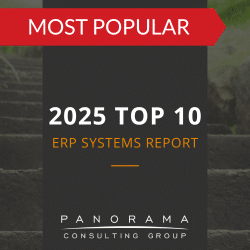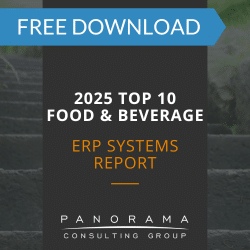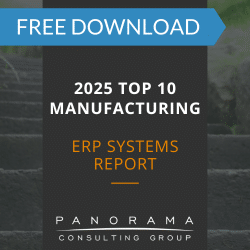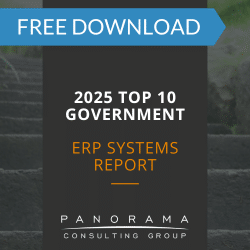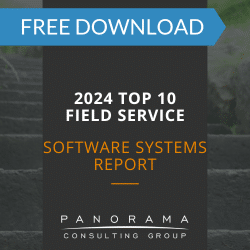Amidst the evolving landscape of global commerce, companies must stay current on the forces and industry trends shaping supply chain management.
Today, we aim to prepare you for successful software selection as we explore current and future technology trends in supply chain management. These supply chain industry trends are critical to understand whether you’re evaluating ERP systems, supply chain management (SCM) systems, or another type of enterprise software.
What Are Some Recent Trends in Supply Chain Management?
1. Cloud-Based SCM Systems
One of the top new technology trends in supply chain management is the increasing adoption of cloud-based SCM systems. These systems enable companies to monitor supply chain activities and collaborate across global networks in real-time.
For example, a supply chain manager at a pharmaceutical company might use cloud-based solutions to detect potential disruptions and adjust operations by shifting inventory levels or altering shipping routes.
Cloud-based SCM software is especially beneficial for companies with dynamic and complex supply chains in need of enhanced scalability. Many of our clients select cloud software to enable real-time monitoring and collaboration across extensive networks.
The 2025 Top 10 ERP Systems Report
What vendors are you considering for your ERP implementation? This list is a helpful starting point.
2. Predictive and Prescriptive Analytics
Predictive and prescriptive analytics are now essential technologies for managing supply chain disruptions and optimizing inventory management.
While predictive analytics provides forecasts of probable outcomes, prescriptive analytics offers recommendations on how to respond to these predictions.
With these tools, supply chain managers can do everything from forecast future resource requirements to reimagine their supply chain planning processes.
For instance, a food and beverage manufacturer might implement advanced analytics when it becomes clear that more accurate demand forecasting is needed to address frequent overproduction.
While advanced analytics tools have proven to be transformative for a variety of industries, our ERP consultants frequently caution clients that adopting advanced analytics requires careful implementation. It’s crucial to establish strong data governance and provide adequate training for staff to fully leverage these tools.
3. Artificial Intelligence and Internet of Things (IoT)
Enterprise technology that enables data-driven decision-making continues to be instrumental in refining supply chain operations. This is especially true now that many ERP systems have been integrated with advanced technologies, like artificial intelligence (AI) and IoT.
AI-powered ERP systems are helping companies process large volumes of real-time data to gain actionable insights. Examples include using logistics data for smarter route planning or using predictive inventory analytics to forecast demand.
In the meantime, IoT sensors are being integrated throughout the supply chain to feed continuous data streams into AI systems.
From sensors embedded in vehicles to smart shelves equipped with weight sensors, IoT technology has a number of ways of collecting data across the supply chain landscape. This enhances the accuracy and timeliness of data insights.
Our ERP software consultants often find that implementing technologies like machine learning and AI requires a clearly defined information strategy. In other words, organizations must clearly define how they will use new data insights to enable their corporate objectives.
Once everyone is on the same page, we take a critical look at the company’s current technology and data so we can determine how to structure and aggregate it to support their business goals.
4. Digital Twin Technology
Enhancing visibility throughout the supply chain is crucial for timely decision-making and efficient resource management.
One way that companies are gaining this visibility is by implementing digital twin technology. This technology can simulate the physical supply chain and predict outcomes based on various scenarios.
As a result, companies can identify bottlenecks and test potential changes to the supply chain process without disrupting operations.
For example, an automotive manufacturer might use digital twins to optimize assembly line configurations for its new electric vehicle range. By creating a digital replica of their production environment, the company could simulate different assembly line setups and workflows to identify the most efficient configurations before any physical changes are made.
The effective use of digital twins in the supply chain requires an integrated approach with existing technologies and data systems. We recommend developing a comprehensive digital strategy to ensure that all digital initiatives align with overarching business objectives.
5. Agile Practices and Collaboration Strategies
The concept of an agile supply chain is increasingly relevant in today’s volatile market. Anticipating and responding to market changes requires flexible processes that can adapt quickly without significant delays or costs.
Agile supply chains utilize tools and strategies such as advanced forecasting, responsive logistics, and flexible resource management. In implementing these strategies, the goal is to offer more reliable service levels in unpredictable markets, while capitalizing on market opportunities faster than peers with more rigid supply chain models.
For instance, a consumer goods company might adopt modular assembly processes in its product manufacturing. This would allow the company to switch production lines within a matter of hours to meet changing consumer preferences.
Collaboration is another cornerstone of agile supply chains. Through strategic partnerships, companies are leveraging shared knowledge, technology, and resources to enhance efficiency and innovation.
From joint ventures and shared logistics to collective procurement, cooperative models enable businesses to share risks and costs while benefiting from the strengths and capabilities of their partners.
Anticipate Your Next Supply Chain Move
For supply chain professionals willing to invest in innovative approaches and technologies, the potential for supply chain resiliency is significant. By improving efficiency, transforming the customer experience, and reducing supply chain risk, companies can better prepare for the data-driven future.
Contact our independent ERP consultants below to learn how to develop a digital strategy to guide your selection of supply chain technology.






